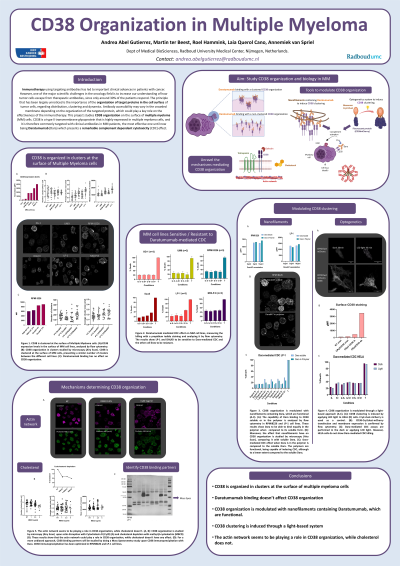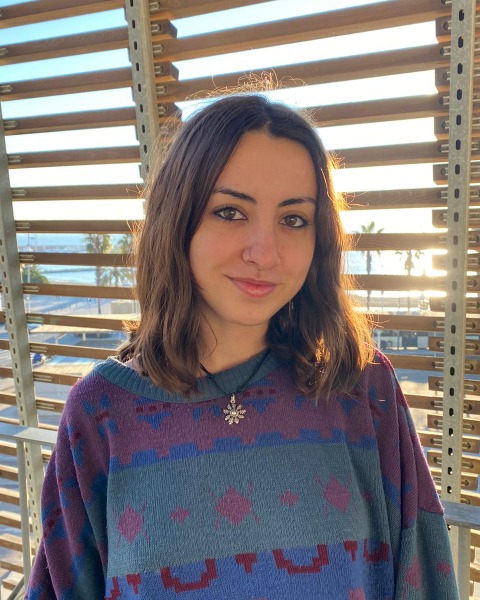Myeloma Microenvironment and immune profiling
Poster Session 3
P-377: CD38 targeting in Multiple Myeloma
Friday, September 29, 2023
1:15 PM - 2:15 PM EEST


Andrea Abel, PhD candidate (she/her/hers)
PhD candidate
Radboud Institute for Molecular Life Sciences (RIMLS)
Nijmegen, Netherlands
Introduction: Despite recent advances in cancer immunotherapies targeting specific tumor proteins, there is a lack of response in patients that cannot be always explained by the expression levels of these targets. We hypothesize that the organization of the targeted proteins on the surface of the tumor cells plays a key role in antibody accessibility in the crowded membrane, and therefore in the effectiveness of these immunotherapies. CD38 is a glycoprotein highly expressed in MM cells, which has postulated it as a therapeutic target using clinical antibodies in MM patients. The most effective clinical antibody is Daratumumab, which presents a remarkable complement dependent cytotoxicity (CDC) effect. We are interested in studying CD38 organization on the surface of multiple myeloma (MM) cells, since we hypothesize that if CD38 is in a more clustered organization rather than randomly distributed, this will facilitate Daratumumab binding, as well as the IgG hexamer formation needed for CDC-mediated tumor cell killing. Similarly, we also aim to unravel the mechanisms determining CD38 membrane organization on MM.
Methods: We study CD38 organization at the surface of Daratumumab resistant and sensitive MM cell line models combining advance confocal microscopy. Furthermore, to prove our hypothesis we also artificially modulate CD38 clustering using nanofilaments containing Daratumumab antibodies and optogenetics, which is a novel method to modulate protein clustering/distribution using light, which we expect will translate into an enhanced Daratumumab-mediated CDC killing. To characterize the mechanisms that determine CD38 organization, we are exploring the role of the actin network, as well as the role of membrane organizers such as Tetraspanins and Galectins. This is being studied by microscopy and immunoprecipitation followed by mass spectrometry.
Results: Our confocal analysis has revealed that both CDC sensitive and resistant MM lines present a similar number of CD38 clusters, although these appear to be larger in our sensitive cell models. We have also seen that the actin network and galectins seem to play a role in CD38 organization. We have successfully immunoprecipitated CD38 and are waiting for the Mass Spectrometry results to dive into the binding partners of CD38.
Conclusions: CD38 is organized in clusters, which appear to be bigger in the CDC sensitive cells, correlating with our hypothesis that a more clustered organization of CD38 leads to an enhanced CDC effect of Daratumumab. Ongoing experiments with the clustering modulators, both intracellularly and extracellularly, will confirm whether enhancing CD38 clustering also leads to an enhanced Daratumumab-mediated tumor cell killing. In parallel, the actin network and galectins appear to be playing a role in determining CD38 surface organization. Moreover, identifying CD38 binding partners at the plasma membrane of MM cells will shed light into the mechanisms governing its distribution and open novel avenues to modulate its clustering.
Methods: We study CD38 organization at the surface of Daratumumab resistant and sensitive MM cell line models combining advance confocal microscopy. Furthermore, to prove our hypothesis we also artificially modulate CD38 clustering using nanofilaments containing Daratumumab antibodies and optogenetics, which is a novel method to modulate protein clustering/distribution using light, which we expect will translate into an enhanced Daratumumab-mediated CDC killing. To characterize the mechanisms that determine CD38 organization, we are exploring the role of the actin network, as well as the role of membrane organizers such as Tetraspanins and Galectins. This is being studied by microscopy and immunoprecipitation followed by mass spectrometry.
Results: Our confocal analysis has revealed that both CDC sensitive and resistant MM lines present a similar number of CD38 clusters, although these appear to be larger in our sensitive cell models. We have also seen that the actin network and galectins seem to play a role in CD38 organization. We have successfully immunoprecipitated CD38 and are waiting for the Mass Spectrometry results to dive into the binding partners of CD38.
Conclusions: CD38 is organized in clusters, which appear to be bigger in the CDC sensitive cells, correlating with our hypothesis that a more clustered organization of CD38 leads to an enhanced CDC effect of Daratumumab. Ongoing experiments with the clustering modulators, both intracellularly and extracellularly, will confirm whether enhancing CD38 clustering also leads to an enhanced Daratumumab-mediated tumor cell killing. In parallel, the actin network and galectins appear to be playing a role in determining CD38 surface organization. Moreover, identifying CD38 binding partners at the plasma membrane of MM cells will shed light into the mechanisms governing its distribution and open novel avenues to modulate its clustering.
